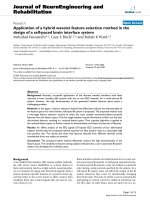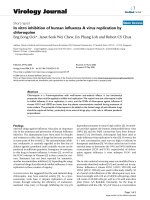advances in thermal design of heat exchangers a numerical approach direct-sizing, step-wise rating, and transients
Bạn đang xem bản rút gọn của tài liệu. Xem và tải ngay bản đầy đủ của tài liệu tại đây (21.41 MB, 530 trang )
Advances
in
Thermal Design
of
Heat
Exchangers
A
Numerical Approach:
Direct-sizing, step-wise rating,
and
transients
Eric
M
Smith
Professional
John Wiley
&
Sons,
Ltd
Advances in Thermal Design of Heat Exchangers: A Numerical Approach: Direct-sizing, step-wise
rating, and transients. Eric M. Smith
Copyright
2005 John Wiley & Sons, Ltd. ISBN: 0-470-01616-7
Advances
in
Thermal Design
of
Heat Exchangers
Related
Titles
Combined Power
and
Process
-
An
Exergy
Approach
Optical Methods
and
Data
Processing
in
Heat
and
Fluid
Flow
Axial-Flow
Compessors
-
A
Strategy
for
Aerodynamic Design
and
Analysis
F
J
Barclay
1
86058
129 3
Edited
by C
Created,
1
86058
281 8
J
Cosgrove,
and J M
Buick
R
H
Aungier
1
86058
422 5
Advances
in
Thermal Design
of
Heat
Exchangers
A
Numerical Approach:
Direct-sizing, step-wise rating,
and
transients
Eric
M
Smith
Professional
John Wiley
&
Sons,
Ltd
Copyright
©
2005 Eric
M.
Smith
Published
by
John Wiley
&
Sons Ltd,
The
Atrium, Southern Gate,
Chichester,
West Sussex
PO19
8SQ, England
Telephone (+44) 1243
779777
(for orders
and
customer service enquiries):
Visit
our
Home Page
on
www.wiley.com
All
Rights Reserved.
No
part
of
this publication
may be
reproduced, stored
in a
retrieval system
or
transmitted
in any
form
or by any
means, electronic, mechanical,
photocopying, recording, scanning
or
otherwise, except under
the
terms
of the
Copyright,
Designs
and
Patents
Act
1988
or
under
the
terms
of a
licence issued
by the
Copyright
Licensing Agency Ltd,
90
Tottenham Court Road, London
WIT
4LP,
UK,
without
the
permission
in
writing
of the
Publisher. Requests
to the
Publisher should
be
addressed
to
the
Permissions Department, John Wiley
&
Sons Ltd,
The
Atrium, Southern Gate,
Chichester, West Sussex PO19 8SQ, England,
or
emailed
to
,
or
faxed
to
(+44) 1243 770620.
This publication
is
designed
to
provide accurate
and
authoritative information
in
regard
to the
subject matter covered.
It is
sold
on the
understanding that
the
Publisher
is not
engaged
in
rendering professional services.
If
professional advice
or
other expert
assistance
is
required,
the
services
of a
competent professional should
be
sought.
Other
Wiley
Editorial
Offices
John
Wiley
&
Sons Inc.,
Ill
River Street, Hoboken,
NJ
07030,
USA
Jossey-Bass,
989
Market Street,
San
Francisco,
CA
94103-1741,
USA
Wiley-VCH
Verlag GmbH,
Boschstr.
12,
D-69469 Weinheim, Germany
John Wiley
&
Sons Australia Ltd,
33
Park Road, Milton, Queensland
4064,
Australia
John
Wiley
&
Sons (Asia)
Pte
Ltd,
2
Clementi Loop #02-01,
Jin
Distripark,
Singapore
129809
John
Wiley
&
Sons Canada Ltd,
22
Worcester Road, Etobicoke, Ontario, Canada
M9W 1L1
Wiley
also publishes
its
books
in a
variety
of
electronic formats. Some content that appears
in
may not be
available
in
electronic
books.
British
Library
Cataloguing
in
Publication Data
A
catalogue record
for
this book
is
available
from
the
British Library
ISBN
1-86058-461-6
Typeset
by
Techset Composition Limited, Salisbury, Wiltshire
Printed
and
bound
in
Great Britain
by
Antony Rowe, Ltd,
Chippenham,
Wiltshire
This book
is
printed
on
acid-free paper responsibly manufactured
from
sustainable forestry
in
which
at
least
two
trees
are
planted
for
each
one
used
for
paper
production.
This
volume
is
dedicated
to
Dorothy
my
wife
for her
unfailing
kindness
and
understanding,
and
to my
three sons
for
their consistent support.
'If
you can
build
hotter
or
colder than anyone
else,
If
you can
build higher
or
faster than anyone else,
If
you can
build deeper
or
stronger than anyone else,
If
Then,
in
principle,
you can
solve
all the
other problems
in
between.'
(Attributed
to Sir
Monty
Finniston,
FRS)
Contents
Chapter
1
1.1
1.2
1.3
1.4
1.5
1.6
1.7
1.8
1.9
1.10
1.11
Chapter
2
2.1
2.2
2.3
2.4
2.5
2.6
2.7
2.8
2.9
2.10
2.11
2.12
2.13
2.14
2.15
2.16
2.17
Chapter
3
3.1
3.2
Preface
Classification
Class definition
Exclusions
and
extensions
Helical-tube, multi-start
coil
Plate-fin
exchangers
RODbaffle
Helically twisted
flattened
tube
Spirally wire-wrapped
Bayonet
tube
Wire-woven
heat exchangers
Porous matrix heat exchangers
Some
possible
applications
Fundamentals
Simple temperature distributions
Log
mean temperature
difference
LMTD-Ntu
rating problem
LMTD-Ntu
sizing problem
Link
between
Ntu
values
and
LMTD
The
'theta'
methods
Effectiveness
and
number
of
transfer
units
e-Ntu
rating problem
e-Ntu
sizing problem
Comparison
of
LMTD-Ntu
and
e-Ntu
approaches
Sizing when
Q
is not
specified
Optimum
temperature profiles
in
contraflow
Optimum
pressure
losses
in
contraflow
Compactness
and
performance
Required
values
of Ntu in
cryogenics
To dig
deeper
Dimensionless groups
Steady-State Temperature
Profiles
Linear
temperature
profiles
in
contraflow
General cases
of
contraflow
and
parallel
flow
xxiii
1
1
1
3
5
6
7
7
8
9
9
10
19
19
21
23
25
26
26
27
31
32
33
34
35
40
42
42
45
47
59
59
61
viii
Contents
3.3
Condensation
and
evaporation
66
3.4
Longitudinal conduction
in
contraflow
67
3.5
Mean temperature
difference
in
unmixed
crossflow
74
3.6
Extension
to
two-pass unmixed crossflow
79
3.7
Involute-curved
plate-fin
exchangers
82
3.8
Longitudinal conduction
in
one-pass unmixed
crossflow
83
3.9
Determined
and
undetermined
crossflow
90
3.10 Possible optimization criteria
92
3.11
Cautionary remark about core pressure loss
92
3.12 Mean temperature
difference
in
complex arrangements
93
3.13 Exergy destruction
94
Chapter
4
Direct-Sizing
of
Plate-Fin
Exchangers
99
4.1
Exchanger lay-up
99
4.2
Plate-fin surface geometries
101
4.3
Flow-friction
and
heat-transfer correlations
103
4.4
Rating
and
direct-sizing design software
103
4.5
Direct-sizing
of an
unmixed crossflow exchanger
106
4.6
Concept
of
direct-sizing
in
contraflow
110
4.7
Direct-sizing
of a
contraflow
exchanger
113
4.8
Best
of
rectangular
and
triangular ducts
120
4.9
Best small, plain rectangular duct
125
4.10 Fine-tuning
of
ROSF surfaces
127
4.11
Overview
of
surface performance
127
4.12
Headers
and flow
distribution
130
4.13
Multi-stream design (cryogenics)
130
4.14
Buffer
zone
or
leakage plate
'sandwich'
130
4.15
Consistency
in
design methods
132
4.16 Geometry
of
rectangular
offset
strip
4.17 Compact
fin
surfaces generally
138
4.18 Conclusions
138
Chapter
5
Direct-Sizing
of
Helical-Tube
Exchangers
143
5.1
Design framework
143
5.2
Consistent geometry
145
5.3
Simplified geometry
151
5.4
Thermal design
153
5.5
Completion
of the
design
159
5.6
Thermal design results
for t/d =
1.346
162
5.7
Fine tuning
163
5.8
Design
for
curved tubes
168
5.9
Discussion
172
5.10 Part-load operation with by-pass control
174
5.11
Conclusions
174
fins
133
Contents
ix
Chapter
6
Direct-Sizing
of
Bayonet-Tube
Exchangers
6.1
Isothermal shell-side conditions
6.2
Evaporation
6.3
Condensation
6.4
Design illustration
6.5
Non-isothermal shell-side conditions
6.6
Special explicit case
6.7
Explicit solution
6.8
General numerical solutions
6.9
Pressure loss
6.10 Conclusions
Chapter
7
Direct-Sizing
of
RODbaffle
Exchangers
7.1
Design
framework
7.2
Configuration
of the
RODbaffle
exchanger
7.3
Approach
to
direct-sizing
7.4
Flow areas
7.5
Characteristic dimensions
7.6
Design correlations
7.7
Reynolds numbers
7.8
Heat transfer
7.9
Pressure loss tube-side
7.10 Pressure loss shell-side
7.11
Direct-sizing
7.12
Tube-bundle diameter
7.13 Practical design
7.14 Generalized correlations
7.15
Recommendations
7.16
Other
shell-and-tube
designs
7.17 Conclusions
Chapter
8
Exergy
Loss
and
Pressure
Loss
Exergy
loss
8.1
Objective
8.2
Historical development
8.3
Exergy change
for any flow
process
8.4
Exergy loss
for any
heat exchangers
8.5
Contraflow
exchangers
8.6
Dependence
of
exergy
loss
number
on
absolute
temperature level
8.7
Performance
of
cryogenic plant
8.8
Allowing
for
leakage
8.9
Commercial considerations
8.10
Conclusions
177
177
178
189
190
191
194
196
199
201
204
207
207
208
208
209
209
210
211
211
213
214
215
217
217
220
222
222
224
229
229
229
230
231
233
234
236
238
240
242
242
x
Contents
Pressure
loss
8.11
Control
of flow
distribution
8.12
Header design
8.13
Minimizing
effects
of flow
maldistribution
8.14 Embedded heat exchangers
8.15
Pumping
power
Chapter
9
Transients
in
Heat Exchangers
9.1
Review
of
solution methods
-
contraflow
9.2
Contraflow
with
finite
differences
9.3
Further considerations
9.4
Engineering applications
-
contraflow
9.5
Review
of
solution methods
-
crossflow
9.6
Engineering applications
-
crossflow
Chapter
10
Single-Blow Test Methods
10.1
Features
of the
test method
10.2 Choice
of
theoretical model
10.3 Analytical
and
physical assumptions
10.4 Simple theory
10.5 Relative accuracy
of
outlet response curves
in
experimentation
10.6 Conclusions
on
test methods
10.7 Practical considerations
10.8 Solution
by finite
differences
10.9 Regenerators
Chapter
11
Heat
Exchangers
in
Cryogenic Plant
11.1
Background
11.2
Liquefaction concepts
and
components
11.3
Liquefaction
of
nitrogen
11.4 Hydrogen liquefaction plant
11.5
Preliminary direct-sizing
of
multi-stream
heat
exchangers
11.6
Step-wise
rating
of
multi-stream heat exchangers
11.7
Future commercial applications
11.8
Conclusions
243
243
244
250
251
253
257
257
259
265
266
267
268
275
275
276
277
278
284
287
287
289
290
297
297
298
307
313
314
317
321
322
Chapter
12
Heat
Transfer
and
Flow
Friction
in
Two-Phase Flow
12.1
With
and
without phase change
12.2
Two-phase
flow
regimes
12.3 Two-phase pressure loss
325
325
326
327
Contents
xi
12.4 Two-phase heat-transfer correlations
12.5 Two-phase design
of a
double-tube exchanger
12.6 Discussion
12.7 Aspects
of air
conditioning
12.8 Rate processes
331
333
336
340
343
Appendix
A
Transient Equations with Longitudinal
Conduction
and
Wall Thermal
Storage
349
A.
1
Mass
flow and
temperature transients
in
contraflow
349
A.2
Summarized development
of
transient equations
for
contraflow
352
A.3
Computational approach
355
Appendix
B
Algorithms
And
Schematic Source Listings
B.I
Algorithms
for
mean temperature distribution
in
one-pass unmixed
crossflow
B.2
Schematic source listing
for
direct-sizing
of
compact one-pass
crossflow
exchanger
B.3
Schematic source listing
for
direct-sizing
of
compact
contraflow
exchanger
B.4
Parameters
for
rectangular
offset
strip
fins
B.5
Longitudinal conduction
in
contraflow
B.6
Spline-fitting
of
data
B.7
Extrapolation
of
data
B.8
Finite-difference solution schemes
for
transients
361
361
364
365
366
370
375
376
377
Supplement
to
Appendix
B -
Transient Algorithms
383
Appendix
C
Optimization
of
Rectangular Offset Strip,
Plate-Fin
Surfaces
405
C.I
Fine-tuning
of
rectangular
offset
strip
C.2
Trend curves
407
C.3
Optimization graphs
408
C.4
Manglik
&
Bergles correlations
409
Appendix
D
Performance Data
for
RODbaffle
Exchangers
411
D.I
Further heat-transfer
and flow-friction
data
411
D.2
Baffle-ring
by-pass
414
Appendix
E
Proving
the
Single-Blow
Test
Method
-
Theory
and
Experimentation
419
E.I
Analytical approach using Laplace transforms
419
fins
405
xii
Contents
E.2
Numerical evaluation
of
Laplace outlet response
420
E.3
Experimental test equipment
423
Appendix
F
Most
Efficient
Temperature Difference
in
Contraflow
425
F. 1
Calculus
of
variations
425
F.2
Optimum temperature
profiles
426
Appendix
G
Physical Properties
of
Materials
and
Fluids
429
G.I
Sources
of
data
429
G.2
Fluids
429
G.3
Solids
431
Appendix
H
Source
Books
on
Heat Exchangers
433
H.I
Texts
in
chronological order
433
H.2
Exchanger types
not
already covered
439
H.3
Fouling
-
some recent literature
442
Appendix
I
Creep Life
of
Thick Tubes
443
1.1
Applications
443
1.2
Fundamental equations
443
1.3
Early work
on
thick tubes
445
1.4
Equivalence
of
stress systems
446
1.5
Fail-safe
and
safe-life
447
1.6
Constitutive equations
for
creep
447
1.7
Clarke's creep curves
449
1.8
Further
and
recent developments
451
1.9
Acknowledgements
451
Appendix
J
Compact Surface Selection
for
Sizing Optimization
455
J.
1
Acceptable
flow
velocities
455
J.2
Overview
of
surface performance
455
J.3
Design problem
458
J.4
Exchanger optimization
466
J.5
Possible surface geometries
467
Appendix
K
Continuum Equations
469
K.I
Laws
of
continuum mechanics
469
K.2
Coupled continuum theory
473
K.3
De-coupling
the
balance
of
energy equation
474
Appendix
L
Suggested
Further Research
477
L.I
Sinusoidal-lenticular
surfaces
477
L.2
Steady-state
crossflow
478
Contents
xiii
L.3
Header design
L.4
Transients
in
contraflow
Appendix
M
Conversion
Factors
Notation
Commentary
Chapter
2
Chapter
3
Chapter
4
Chapter
5
Chapter
6
Chapter
7
Chapter
8
Chapter
9
Chapter
10
Chapter
11
Chapter
12
Appendix
A
Appendix
I
Index
Fundamentals
Steady-state temperature
profiles
Direct-sizing
of
plate-fin
exchangers
Direct-sizing
of
helical-tube exchangers
Direct-sizing
of
bayonet-tube exchangers
Direct-sizing
of
RODbaffle
exchangers
Exergy
loss
and
pressure loss
Transients
in
heat
exchangers
Single-blow test methods
Heat
exchangers
in
cryogenic plant
Heat
transfer
and flow
friction
in
two-phase
flow
Transient equations with longitudinal conduction
and
wall thermal storage
Creep
life
of
thick tubes
478
479
483
487
487
488
489
490
491
493
494
495
496
497
498
499
500
501
503
XIV
THERMAL DESIGN
ROADMAP
(outline
guide
for
contraflow)
DIRECT-SIZING
(minimum
input data required)
INPUT DATA
contraflow
Qduty
OPTIMAL TEMPERATURE DISTRIBUTION
Grassman
&
Kopp
exergy
constraint
-—-
—
const.
Ntu
VALUES
{find
T
h2
T
c
i}
EXCHANGER
TYPE
Plate-fin
Helical-tube
RODbaffle
MEAN
PHYSICAL PROPERTIES
specific
heats
absolute viscosities
thermal conductivities
LMTD-nT
approach
approach
XV
APPLY
LMTD
Qduty
UxS
=
LMTD
COMPACT
PLATE-FIN
GEOMETRIES
heat-transfer
correlations
flow-friction
correlations
FIXED GEOMETRIES
K&L
correlations
1
L&S
correlations
|
range
of
validity
J
=spline-fits=>-
VARIABLE
GEOMETRIES
(
M&B
correlations
I
(ROSF
variable)
[
range
of
validity
DIRECT-SIZING
block heat exchanger
equivalent plate with half-height surfaces
optimal
pressure
loss
exergy
constraint
but
preferably design with
Ma <
0.1
FOR
RANGE
OF Re
VALUES
FOR
SIDE-1
GENERATE
heat-transfer
curve
pressure-loss curve,
Side-1
pressure-loss curve, Side-2
FIXED GEOMETRIES
coincidence
of
Ap
curves unlikely
VARIABLE
GEOMETRIES
coincidence
of
Ap
curves
possible
XVI
NEAR-OPTIMUM EXCHANGER
estimated
cross-section
and
length
LONGITUDINAL
CONDUCTION
(reduced
performance
in
most
exchangers)
STEADY-STATE TEMPERATURE PROFILES
three simultaneous partial
differential
equations
(
hot
fluid
balance
of
energy
}
solid
wall
balance
of
energy
\
cold
fluid
balance
of
energy
J
LMTD REDUCTION
(allowing
for
longitudinal conduction)
KROEGER
SOLUTION
equal water equivalents
|
analytical solution
I
greatest conduction
GENERAL SOLUTION
unequal
water equivalents
f
numerical solution
1
1
Crank-Nicholson
I
APPLY CORRECTION
TO
DIRECT-SIZING LMTD
leading
to
CONSERVATIVE DIRECT-SIZING DESIGN
with
mean
thermophysical
values
accurate cross-section
and
length
OPTIMIZED DESIGN
vary
local surface geometries
until
Ap
curves coincide
XVII
STEP-WISE
RATING
(using
cross-section
from direct-sizing)
AWKWARD
CONDITIONS
arbitrary temperature
profiles
physical properties varying along length
FOR
TEMPERATURE RANGE
OF
EXCHANGER
spline-fit
thermophysical
data
for
interpolation
SECTION-WISE
DESIGN
assume equal temperature intervals
for one fluid
and
use
enthalpy balance
to
calculate
corresponding temperatures
for
other
fluid
LMTD
AND
MEAN TEMPERATURES
AT
EACH SECTION
thermophysical properties
for
each section
using
spline-fitted data
CALCULATE SURFACE AREA
AND
LENGTH
for
each section
CALCULATE PRESSURE LOSS
FOR
EACH FLUID
for
each section
SUM
LENGTHS
AND
PRESSURE LOSSES
to
obtain
final
step-wise design
MULTI-STREAM
DESIGN
(refer
to
specialist papers
for
cross-conduction
and
near-optimization)
XVIII
TRANSIENTS
(for
known steady-state
design)
COMBINED MASS FLOW
AND
TEMPERATURE TRANSIENTS
temperature-dependent physical properties
seven
simultaneous partial differential equations
balance
of
mass
hot
fluid
balance
of
linear momentum
balance
of
energy
solid
wall
—
balance
of
energy
balance
of
energy
cold fluid
balance
of
linear momentum
balance
of
mass
FINITE-DIFFERENCE SOLUTION
solve sequentially
by finite
differences
two
pairs
of
outer equations
for
density
and
velocity
three simultaneous central equations
for
temperature
field
DELAYED ENTRY
TO
INDIVIDUAL CHANNELS
AND
CROSS-CONDUCTION
EFFECTS
(refer
to
specialist
papers)
In
general,
finite-difference
schemes were preferred
for
both steady-state
analysis,
and for
transients,
as
temperature-dependent physical properties
could
then most easily
be
accommodated.
About
the
Author
Eric Smith
is a
Fellow
of
both
the
Institution
of
Mechanical Engineers
and of the
American Society
of
Mechanical Engineers,
and is
also
a
Member
of the
Institute
of
Refrigeration.
He
received
his BSc and PhD
degrees
from
the
University
of
Glasgow.
His
early research
on the
strength
of
high-temperature materials
was
com-
plemented
by an
interest
in
heat transfer.
His
early career included
a
total
of 5
years
in
civil nuclear engineering
research
at
C.A.
Parsons
& Co. Ltd of
Newcastle
upon
Tyne
and at the
Institut
fur
Reaktor
Bauelemente,
Kernreaktor
Kernforschungszentrum,
Karlsruhe.
The
next
20
years involved teaching
and
research
to
post-graduate level
in
Mechanical
Engineering
at the
University
of
Newcastle upon Tyne.
Dr
Smith
has
published with
IMechE,
ASME,
and
ASTM,
and has
presented
papers
at
international
and
national
level.
He has
represented
the UK at a
Nato
AGARD
Special Technical Meeting
in
Washington
DC, and was
retained
as an
expert witness
by
Norton Rose
of
London
on
behalf
of
shipbuilders
Harland
and
Wolff
of
Belfast.
Following short periods
in
Defence Consultancy
in the UK, and
teaching engi-
neering
in
Hong Kong,
he
returned
to the UK to
pursue
his
interests
in
long-range
engineering.
The
Book
All
material presented
in
this volume
has
been computed
from
scratch
by the
author,
and
a
number
of new
points
of
understanding have been uncovered. Specifically
and
illustratively:
•
Alternative
Effectiveness
-Ntu
and
LMTD-Ntu
approaches
to
design
are
shown
to be
equivalent
in
finding
terminal temperatures
or Ntu
values.
•
Recommended
Ntu
performance limits
for
parallel
flow,
crossflow,
and
contra-
flow
designs have been established, permitting appropriate choice
for
duty.
•
With
the
LMTD-Ntu
approach, longitudinal conduction
can be
approximated
by
calculating
the
LMTD reduction factor
in
contraflow sizing.
• The
application
of
direct-sizing
to
three
different
types
of
heat exchanger
is
presented
in
some
detail,
and
matching
of
local surface geometries prior
to
direct
sizing
is
explored.
• An
unambiguous measure
of
specific thermal performance
is
defined,
appli-
cable
to all
types
of
exchanger.
•
Exergy loss number
is
defined,
and its
relation
to
quality
of
heat exchange
and
absolute temperature
level
of
operation
developed.
Elimination
of
pressure
losses
in
headers,
and the
proper
way of
evaluating pumping power
are
presented.
•
Methods
are set out for
predicting
full
transients
in
contraflow
allowing
for
temperature-dependent physical properties.
The
single-blow method
for
deter-
mining
heat-transfer
and flow-friction
correlations
is
outlined.
•
Aspects
of
design
for
cryogenic
and
two-phase
flow
problems
are
examined.
•
Numerical methods
are
emphasized throughout, starting
from
the
controlling
differential
equations
and
building towards understanding
of
thermal design
at
every
level.
Preface
'I
would like
to
extend
the way in
which
you may
think
about
the
design
of
heat
exchangers '
(author,
10th International
Heat
Transfer
Conference,
Brighton
1994)
Purpose
of
this
work
The
primary objective
in any
engineering design process
has to be the
elimination
of
uncertainties.
In
thermal design
of
heat exchangers there
are
presently many stages
in
which assumptions
in
mathematical solution
of the
design problem
are
being
made. Accumulation
of
these assumptions (e.g.
use of
mean values)
may
introduce
variations
in
design
as
large
as the
uncertainties introduced
in
heat-transfer
and flow-
friction
correlations.
The
designer needs
to
understand where these inaccuracies
may
arise,
and
strive
to
eliminate
as
many sources
of
error
as
possible
by
choosing
design
configurations that
avoid
such
problems
at
source.
This book
is set at
research graduate
and
professional level
in
clean technologies,
and
is
designed
as a
reference text. Theory
is
explained simply,
so
that
the
reader
can
develop
his/her
own
approach
to
solution
of
problems.
The
text
is not
intended
as a
collection
of
heat-transfer
and
pressure-loss correlations, although
a
fair
amount
of
such
material
has
been included.
Historical
development
of the
subject
Up
until
the
early 1940s virtually
all
papers employ
'mean
temperature
difference'
as the
design parameter,
a
good
collection
being
found
in the two
reference volumes
by
Jakob
(1949,
1957). Around 1942
the
method
of
designing contra-parallel-flow
heat exchangers
was
effectively changed
by
London
&
Seban
(1980)
from
using
LMTD
to
using
the
s-Ntu
approach, partly
on the
grounds that
the
LMTD
approach
did not
give explicit results
in
some elementary cases,
and
partly because
the
concept
of
'effectiveness'
provided
a
measure
of the
approach
to
ultimate perform-
ance
of the
exchanger.
The
consequence
has
been that since 1942 many important papers have concen-
trated
on
expressing results
in
terms
of
effectiveness
in
preference
to
mean tempera-
ture
difference,
which
in
this author's view
has not
been entirely
beneficial,
particularly
in the
case
of
variable
thermophysical
properties
(Soyars,
1992),
and in
the
case
of
crossflow.
The
separate concepts
of
mean temperature
difference
and of
effectiveness
both have
useful
roles
to
play
in
assessing
the
performance
of
heat
exchangers
and
should
be
used
in
combination.
xxiv Preface
The
present treatment shows that:
• The
LMTD-Ntu
approach
is
fully
explicit
in
finding
terminal temperatures
in
contraflow
and
parallel
flow, and
contains expressions
for
'energy'
and
'rate'
processes
(
iteration cannot
be
avoided when only inlet temperatures
and
LMTD
are
known
and
outlet temperatures
are
required).
•
Effectiveness
may be a
measure
of
performance
for
entropy
loss,
but
exergy
loss number
is
essential
in
cryogenics. Aiming
for
minimum entropy gener-
ation
in
contraflow
leads
to
temperature
profiles
with
a
pinch point
at the
hot
end, while aiming
for
least exergy loss
in
contraflow leads
to
temperature
profiles
with
a
pinch point
at the
cold end.
•
Exchanger comparisons
are
best made using
the
specific performance para-
meter
where
S
re
f
is the
reference surface.
The
case
of
unmixed-unmixed
two-pass
crossflow
is
examined
in
some detail.
The
very comprehensive analytical paper
by
Baclic
(1990)
which examines
72
poss-
ible configurations
for
two-pass
crossflow,
concentrates
on
presenting results
in
terms
of
effectiveness
alone. However, understanding
has
been
lost
in not
computing
temperature sheets,
and for
accurate design
the
assumption
of
equal mass
flowrate at
inlet
to
each channel should
be
replaced
by the
assumption
of
equal pressure loss
in
each
flow
channel.
Dow's
(1950)
approach
for
designing headers with zero pressure
loss
allows concentration
on
core pressure loss.
Direct-sizing
methods
'Sizing'
methods have traditionally posed more problems than
'rating'
methods.
Guessing
one
principal dimension
of the
exchanger
may be
necessary before
the
per-
formance
of the
core
can be
compared with design requirements.
For the
class
of
heat
exchangers
in
which
'local'
geometry
of the
heat-transfer surface
is
fully
repre-
sentative
of the
whole geometry, guessing
is no
longer
necessary.
Methods
of
direct-
sizing
go
straight
to the
dimensions
of the
heat exchanger core, while
satisfying
all
thermal performance constraints.
Design
approaches
for
contraflow
Data
Given
Inlet values
Find
Rating
block size
Lx
W xH
m
h
,
C
h
,
T
h
\
m
c
,
C
c
,
T
C
2
thermal duty
Direct sizing
thermal duty
Q,
dP
h
,
dP
c
m
h
,
C
h
,
T
h
i
m
c
,
C
c
,
T
c2
block
size
Preface
xxv
In
direct-sizing,
the
design approach
is
limited
to
that
class
of
heat exchangers
in
which
'local
geometry'
is
fully
representative
of the
complete heat exchange
surface
and
which provide core layouts which eliminate/minimize parasitic
losses
due to
flow
leakage
and
by-pass
flows,
typically those described
by
Tinker
1
(1951,
Part
I,
Fig.
6).
The
concept
can be
applied
to
such
different
designs
as:
compact
plate-fin
exchangers
helical-tube, multi-start
coil
exchangers
platen-type heat exchangers
RODbaffle
shell-and-tube
exchangers
lamella heat exchangers
flattened
and
helically twisted tubes
printed-circuit
heat exchangers
HELIXCHANGERs
As
all
terminal temperatures
may be
determined
in
advance
of
direct-sizing,
the
necessary input data
for
complete sizing take
the
following
form:
exchanger
duty
(Q)
mean
temperature
difference
for
heat exchange
(A0
m
)
'local'
geometry
on
both sides
mass
flowrates of
both
fluids
(m)
physical
properties
for
both
fluids at
mean bulk temperature
(Pr,
C, 17, A)
allowable pressure loss data (AP,
P,
Tbuik,
Rgas)
physical
properties
of
material
of
construction
(A, p, C)
For the
selected geometry,
the
standard procedure
is to
evaluate heat-transfer per-
formance
over
the
range
of
valid Reynolds numbers
for
both sides
of the
exchanger.
This provides
a
heat-transfer curve. Pressure-loss performance
is
similarly evaluated
for
both sides over
the
same range
of
valid Reynolds numbers, providing
two
sep-
arate pressure-loss curves. Both pressure-loss curves will intersect
the
heat-transfer
curve,
and the
intersection
furthest
to the
right provides
the
initial design point.
In
cases where heat-transfer
and
pressure-loss correlations
are
suitable
a
fully
algebraic solution
may be
possible
- as
with
the
helical-tube, multi-start coil heat
exchanger. More
often
a
numerical approach
is
preferred because
the
interpolating
cubic
spline-fit provides more accurate
temperature-dependent
physical
properties
plus heat-transfer
and flow-friction
coefficients,
with
the
special advantage that
spline-fits
cannot
be
extrapolated outside
the
range
of
their validity.
Longitudinal
and
cross-conduction
Techniques
for
estimating longitudinal conduction
effects
in
both
contraflow
and
crossflow
exchangers
are
described.
Longitudinal conduction reduces exchanger
performance,
and the
design approach
is to
calculate
and
apply
the
reduction
in
mean temperature
difference.
xxvi
Preface
With
multi-stream
and
crossflow
exchangers,
an
additional problem exists,
caused
by fluids flowing in the
same direction having
different
temperature
profiles
along
the
length
of the
exchanger. Cross-conduction
effects
may
then have
to be
taken into account.
Step-wise
rating
When changes
in
thermophysical
properties
are
significant,
and it is not
desired
to go
to
full
transient analysis,
it may be
appropriate
to
design
by
step-wise rating.
To
start
this process
an
initial cross-section
of the
exchanger
is
required,
and
direct-sizing
can be
helpful
in
providing
the
start-up information.
By
using temperature-
dependent physical properties,
and
evaluating LMTD
for
each section,
the
design
can
be
made more accurate. Step-wise rating
is the
intermediate stage between
design
assessment using mean values
and
full
numerical prediction
of
transient
performance
of a
design.
Transient
response
In
contraflow exchangers which experience transient temperature disturbances,
longitudinal conduction terms appear
in the set of
seven simultaneous partial
differ-
ential equations.
As the
Mach number
in
heat exchangers
is
normally
less
than
(Ma
=
0.1)
it
becomes practicable
to
separate
the
problem into solution
of
mass
flowrate
and
temperature-field disturbances.
A
full
numerical study
of
transients
in a
two-stream
contraflow
exchanger
involves preparation
of
interpolating cubic
spline-fits
for
both heat-transfer
and
flow-friction
data against Reynolds number,
and for all
temperature-dependent
physical parameters.
At
least
50
stations along
the
length
of a
contraflow
exchanger
are
desirable.
Single-blow
testing
To
measure heat-transfer
and flow-friction
performance
of
heat exchanger surfaces
the
contraflow transient equations
are
simplified
to the
point where they become
the
Single-Blow Transient Test Equations. This method
of
obtaining data
for
heat-
transfer
and flow-friction
correlations
is
well established
as
reliable, providing
that
assumptions
in the
mathematical analysis
are
correctly matched
to the
exper-
imental method.
Arbitrary inlet temperature disturbances
and
longitudinal conduction
effects
in a
matrix
involve
deeper
analytical theory than presented
in
this text.
A
subset
of the
full
transient equations, combined with
a
numerical approach
is one way
forward.
The
extraction
of
dimensionless numbers
from
governing
differential
equations
is
covered
in
outline,
to
reveal
the
extent
of
their limitations when incorporated
in
heat-transfer
and flow-friction
correlations. Rayleigh's empirical approach
and
Buckingham's
7r-method
are not
included
as
they
are
readily available elsewhere.
linker's
work
on
baffle
losses
in
shell-and-tube
exchangers
has
been
reproduced
in
textbooks
and
papers
since
Me
Adams
(1954).









